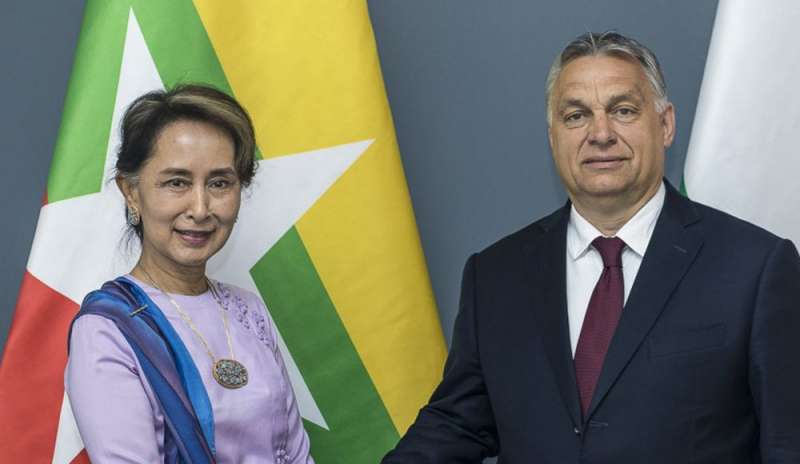The two Oxford-educated leaders once preached liberal values—but found bigotry more convenient.

Aung San Suu Kyi was awarded the Nobel Peace Prize in 1991 for her pro-democracy activism and her resilience in advocating for the cause of democracy in the face of terrible repression by the socialist military junta of Myanmar.
Around the same time, a young Viktor Orban was feted as one of Europe’s future democratic leaders after playing an instrumental role in Hungary’s post-communist transition to democracy. Had the field been less crowded in Europe, Orban could well have been nominated for the same honor as Aung San Suu Kyi, and for the same reasons.Trending Articles
Back then, you would have expected the fellow University of Oxford graduates to have a lot in common. Alas, the two also have much in common today—just all the wrong things. A summit between the two on June 5 epitomized the painful truth: On opposite sides of the earth, the two leaders have converged toward the same rejection of everything they once stood for.
Orban is reviled by many at the moment as the spiritual father of European right-wing populist illiberal democracy. He is a highly successful domestic politician who casts a long shadow over European politics and the West’s long-standing efforts for a peaceful and cohesive Europe under a liberal political and economic consensus.
He rose to power as a traditional center-right Christian democrat, in the mold of the German center-right Christian Democratic Union of Angela Merkel. But in the face of weak opposition from the center-left in Hungary and a threat from the more nationalistic, hard-right Jobbik party, he tacked right. And hard. Jobbik still exists in Hungary, but the erstwhile hard-right alternative is now positioning itself as a more centrist rival to Orban’s Fidesz party.
Meanwhile, Orban and his allies have captured virtually all the mainstream media in Hungary. The 2010 electoral returns gave him a supermajority in parliament, enabling him to change the constitution to permanently entrench an electoral advantage for his party, as well as to weaken the judiciary and the Constitutional Court in the face of the executive.
These power grabs have developed alongside each other with a mutually reinforcing narrative of Hungarian ethnonationalist exceptionalism amid supposed permanent threats from external and internal enemies. The list of enemies is also highly predictable: Jews, most notably in the form of the boogeyman-in-chief, George Soros; Western liberals, under the heading of “Brussels”; Roma, derogatorily called Gypsies, naturally; and Eastern Europe’s favorite historical antagonists, Muslims.
Orban’s path toward autocracy was voluntary—and driven at least in part by his need to shield himself from charges of corruption. Aung San Suu Kyi’s rise to power has been much less smooth and her turn toward oppression much more tragic. She spent much of the 1990s and early 2000s under house arrest in Myanmar, after her political movement, the National League for Democracy (NLD), posed a constant democratic threat to the entrenched political power of the military in her country.
Things came to a head after Cyclone Nargis in 2008, when the shambolic response of the military government to the natural disaster it gave them so much authority that it had to concede to a constitutional change and a so-called managed transition to democracy.
It was now seen as inevitable that Aung San Suu Kyi and her NLD would come to the political fore. What was not anticipated was the price that they would be willing to pay to come to power. The managed transition would mean that the military maintained full control of defense, security, foreign affairs, and strategic economic sectors—effectively all functions of the state that constitute its de jure but also de facto sovereignty—while the civilian government would be allotted the largest proportion of legislative seats to be democratically elected and would be given responsibility over areas of governance that did not interfere too much with the military’s interests and concerns.
Aung San Suu Kyi and her NLD finally ascended to their allotted role within Myanmar’s new constitutional arrangements in 2014. This was hailed as a huge step forward for a country that had suffered under five decades of military rule, and the international community regarded it as inevitable that the country would move ever more toward the Western model of liberal democracy under the leadership of Aung San Suu Kyi.
Then the 2017 Rohingya crisis happened, when the military proceeded with so-called clearing operations against the Rohingya Muslim minority in the west of the country, ethnically cleansing over 1 million people and pushing them over the border to Bangladesh. Only about 300,000 Muslims remain in the region of their birth in western Myanmar, and over a third of them are effectively captive in refugee camps. Whether out of political expedience or personal conviction, Aung San Suu Kyi and her party backed the military against the Rohingya, whom they call “Bengali Muslims,” in this conflict. And to the shock of her erstwhile fans in the West, “The Lady” became a cheerleader for Islamophobia and ethnic cleansing.
Myanmar and Hungary also have some peculiar things in common. Hungary to the west and Myanmar to the east are both at the very historical periphery of the Muslim world at its greatest extent. Hungarian national identity has long defined itself around ideas of resistance, and with the Austrians and the Soviets no longer in the picture, nationalists have turned back to older stories of Christian resistance to Muslim Ottoman expansion into Europe. And similarly, Burmese national identity defines itself, more so now than perhaps in the past, in terms of Buddhist resistance to Mogul Muslim expansion into Southeast Asia.
All this is happening against the context of an emergent, U.S.-led global cultural awareness, which in the post-9/11 era has normalized Muslims as Public Enemy No. 1.
All this is happening against the context of an emergent, U.S.-led global cultural awareness, which in the post-9/11 era has normalized Muslims as Public Enemy No. 1.
So if you are a national leader who is looking for scapegoats, for whatever reason, and you also have a national historical narrative deeply tied to the current global hate figures, “the Muslims” are a perfect target.
And so, when Aung San Suu Kyi and Orban finally met on June 5, their strangely parallel stories finally converged. Aung San Suu Kyi, the global pro-democracy and humanitarian icon fallen from grace, scraping around for any form of international recognition and prestige, ended up in the company of Europe’s most prominent outcast. Orban, once the bright hope of Europe’s future, was seeking solace after that slap in the face from European Commission President Jean-Claude Juncker and the rest of Europe from a woman who has not even begun to wash the Muslim blood off her hands.
These two tarnished icons, now spurned by disappointed humanitarians and former Western friends, bonded over their favorite far-right tropes such as the supposedly “continuously growing Muslim populations” in Myanmar and in Europe, the “fake news media,” and their beastly liberal critics.
In the final analysis, though, both have found their way to power. And both have found that decency, morality, ideals, and reputation were things they were willing to sacrifice to gain and hold on to power.
They both may have been ostracized from the democratic free world, but they both found new friends among the autocrats in Beijing for Aung San Suu Kyi and Moscow for Orban. And it turns out that there is a market out there for an Islamophobia International, which can be milked by both as a way to shore up the domestic base.
They are now, as they would have been in the early 1990s, kindred spirits. The problem, however, is that they are not alone. U.S. President Donald Trump is obviously a fan of Orban and his style of politics. Prime Minister Narendra Modi in India, whom Aung San Suu Kyi meets with often, has found much political mileage in pushing a Hindu supremacism and violence against India’s substantial Muslim minority. And the only reason Brazil’s President Jair Bolsonaro might feel excluded here is because he does not have many Muslims at hand to brutalize.
Just as they did in the 1920s and 1930s, the forces of religious and ethnonationalist supremacism are on the rise, and, for now at least, they can find common ground among themselves against supposed international and internationalist conspiracies of humanist equality and decency, as they seek to buttress one another’s international standing and protect themselves from domestic accountability for their corruption and failures of governance.
They sell the same snake oils: national pride, protection from imagined threats to the volk, Islamophobia and/or anti-Semitism where available, and so on. For the time being, at least, people seem to be buying. And as long as they are, amoral political profiteers who sold out their ideals like Orban and Aung San Suu Kyi will be there to sell.
Azeem Ibrahim is a research professor at the Strategic Studies Institute at the U.S. Army War College and a director at the Center for Global Policy in Washington. He is the author of Radical Origins: Why We Are Losing the Battle Against Islamic Extremism and a former expert advisor to the U.K. government’s Commission for Countering Extremism. Twitter: @azeemibrahimVIEW




